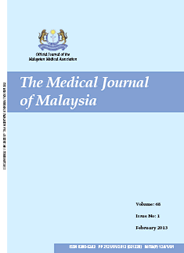MJM, Vol 70 Supplement 1 September 2015
A meta-analysis on the accuracy of dengue diagnostic
tests used for point-of-care testing (POCT) in ASEAN patients
*Medical Statistics Unit, Kulliyyah of Dentistry, International Islamic University Malaysia, **Community Medicine Department, Kulliyyah of Medicine, International Islamic University Malaysia (IIUM), ***Klinik Kesihatan Jaya Gading, Kuantan, ****Primary Care Department, Faculty of Medicine, MAHSA University, Kuala Lumpur, *****Pathology and Laboratory Medicine Department, Kulliyyah of Medicine, International Islamic University Malaysia, ******Family Medicine Department, Kulliyyah of Medicine, International Islamic University Malaysia, *******Department of Community& Family Medicine, Faculty of Medicine and Health, University Malaysia Sabah
ABSTRACT
Introduction: ASEAN countries are included in the 30 most highly dengue endemic countries in the World. Evaluation of the accuracy of dengue diagnostic tests is essential for clinical management, surveillance, control activities and vaccine development. Aim of this study is to review the accuracy of diagnosis tests used for POCT for dengue infection.
Methods: The accuracy results of 31 dengue diagnosis tests in 5308 ASEAN patients except Brunei were extracted from 14 articles published between 2007 and 2014. Rapid diagnosis tests (RDT) and WHO-Clinical criteria were considered for POCT. ELISA tests with/without WHO-Clinical criteria were included in meta-analysis. Pooled sensitivity (SN) and specificity (SP) were computed. Egger-bias was analysed for publication bias.
Results: Pooled (range) SN of NS1(RDT), IgM/IgG(RDT), NS1+IgM/IgG (RDT) and WHO-Clinical criteria were 65% (44-79), 14% (3-50), 80% (69-86) and 93% (80-97) while SP (range) of those tests were 99% (96-100), 97% (93-99), 96% (84-98) and 34% (20-57) respectively. Pooled (range) of SN and SP of NS1 (ELISA) were 64% (45-82) and 99% (93-100. SN/SP (95% CI) of IgM/IgG (ELISA) were 50% (40-60) / 100% (96-100) and those of NS1+IgM/IgG (ELISA) were 94% (89-97)/92 % (81-97) and those of NS1+IgM/IgG (ELISA) with WHO-Clinical criteria were 91% (86-95)/ 94 % (84-98) respectively. Egger-bias was significant (p<0.0001).
Discussion and conclusion: Both RDT and ELISA tests have high SP to rule in dengue diagnosis. Wide range of SN value (WHO-Clinical Criteria vs IgM/IgG RDT) highlighted to improve SN of the tests for ruling out. Added value of dengue epidemic information in the accuracy of the tests should be verified. A multi-centre study with a standardised protocol should be conducted for diagnostic test accuracy variation for POCT among ASEAN patients.
Key words: Meta-analysis, accuracy, dengue diagnostic tests, ASEAN countries, POCT
